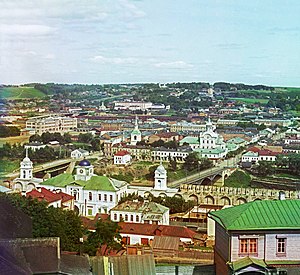| Revision as of 17:09, 7 December 2004 editGhirlandajo (talk | contribs)Autopatrolled, Extended confirmed users, Pending changes reviewers89,629 editsmNo edit summary← Previous edit | Revision as of 17:18, 7 December 2004 edit undoGhirlandajo (talk | contribs)Autopatrolled, Extended confirmed users, Pending changes reviewers89,629 editsNo edit summaryNext edit → | ||
| Line 23: | Line 23: | ||
| In August ] two largest ] ever assembled clashed in Smolensk. During the hard-fought ], described by ] in "]", ] entered the city. Total losses were estimated at 30000 men. The centenary of the battle was commorated with the Eagles monument, unveiled in the central square of Smolensk in ]. | In August ] two largest ] ever assembled clashed in Smolensk. During the hard-fought ], described by ] in "]", ] entered the city. Total losses were estimated at 30000 men. The centenary of the battle was commorated with the Eagles monument, unveiled in the central square of Smolensk in ]. | ||
| During the ] Smolensk was again chosen by history as a stage for one of its greater battles. The first ] counteroffensive against the German army was launched here in August ]. Over 93% of the city was destroyed during the |
During the ] Smolensk was again chosen by history as a stage for one of its greater battles. The first ] counteroffensive against the German army was launched here in August ]. Over 93% of the city was destroyed during the fighting. The ancient icon was lost forever. It is no surprise that the title of ] was bestowed on Smolensk after the war. | ||
Revision as of 17:18, 7 December 2004

Smolensk (Смоленск) is a city in western Russia, located on the Dniepr river at 54.79° North, 32.05° East, administrative center of Smolensk Oblast. Its population in 2003 is 351,100.
The name of the city is derived from the name of Smolnya River. The origin of the river name is less clear. One possibility is the Russian word smola that means both tar and resin. Pine trees grow in the area, and city was once a center of resin procession and trade. An alternative origin could be the old Slavic word smol — black soil.
According to the Russian Primary Chronicle, Smolensk was the capital of the Slavic dregovichi tribe in 882 when it was captured by Prince Oleg of Novgorod. The first foreign writer to mention Smolensk was Constantinos Porphyrogenetos, Emperor of Byzantium. In De Administrando Imperio (ca 950) he described Smolensk as an important fortress of the Rus.
The princedom of Smolensk was founded in 1054. Due to its central position amid Russian lands, Smolensk developed rapidly. By the end of the 12th century the princedom was one of the strongest in Eastern Europe, so that Smolensk princes frequently controlled the Kievan throne. Numerous churches were built in the city during the 12th century, including the church of Sts Peter and Paul (1146, mostly a post-war reconstruction) and church of St John the Baptist (1180, also partly rebuilt). The most remarkable church in the city is called Svirskaya (1197, still standing); it was admired by chroniclers as the most beautiful structure east from Kiev.
Although spared by the Mongol armies in 1240, Smolensk became increasingly a pawn in the long struggle between Lithuania and Muscovy. It was repeatedly taken by the Vytautas the Great in 1395, 1404 and 1408. Three Smolensk regiments proved decisive during the Battle of Grunwald against the Teutonic knights.
With the population of 200000 inhabitants, Smolensk was probably the largest city in Lithuania by 1514, when it was recaptured by Vasili III of Russia. To commemorate this event, the tsar founded in Moscow the Novodevichi convent, dedicated to the holy icon of Our Lady of Smolensk.
In order to repel future Polish attacks, Boris Godunov made it his priority to heavily fortify the city. The kremlin constructed in 1597-1602 is the largest in Russia. Heavy fortifications didn't prevent the city from being surrendered to the Poles during the Time of Troubles. To recapture the city, Muscovy launched the "Smolensk War" against Poland in 1632. After prolonged warfare, king Wladislaw IV had to evacuate the city in 1634.
Smolensk has been a special city for Russians for many reasons, not least for the fact that the local cathedral housed one of the most venerated Orthodox icons, attributed to St Luke. Building the new Cathedral of the Assumption was a great project which took more than a century to complete. Despite slowly sinking into economic backwater, Smolensk was still valued as a key fortress defending the route to Moscow. It was made the capital of guberniya in 1708.
In August 1812 two largest armies ever assembled clashed in Smolensk. During the hard-fought battle, described by Leo Tolstoy in "War and Peace", Napoleon entered the city. Total losses were estimated at 30000 men. The centenary of the battle was commorated with the Eagles monument, unveiled in the central square of Smolensk in 1912.
During the WWII Smolensk was again chosen by history as a stage for one of its greater battles. The first Soviet counteroffensive against the German army was launched here in August 1941. Over 93% of the city was destroyed during the fighting. The ancient icon was lost forever. It is no surprise that the title of Hero City was bestowed on Smolensk after the war.
External links
- Official Website of Smolensk (in Russian)
- Web discussion board of Smolensk region (in Russian)
- Official Website of Smolensk region (oblast) (in Russian)